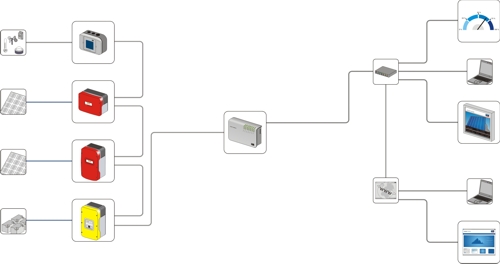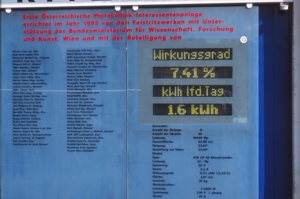Photovoltaic system Monitoring
Monitoring and control of photovoltaic systems is essential for reliable functioning and maximum yield of any solar electric system. The simplest monitoring of an inverter can be performed by reading values on display - display (usually LCD) is part of almost each grid-connected inverter. Most important inverter and grid related parameters are available on LCD screen in such case. Values like PV array power, AC grid power, PV array current are usually available. For sophisticated monitoring and control purposes environmental data - like module temperature, ambient temperature, solar radiation, wind speed can also be data logged, stored and analysed later. Remote control and monitoring can be performed by various remote connections: analog modem, ISDN, GSM etc. The most common connection for local/remote control are USB (sometimes even RS232) for local monitoring, RS485 and powerline for inverter interconnection. For wireless connection Bluetooth and Wi-Fi are most common used.
Local monitoring
Most simple way to perform local monitoring is display available on inverter or on inverter control unit. Other possibilities of local monitoring includes monitoring by local PC via RS232 connection and/or remote display located in living room for example (connection between inverter and display is usually wireless). The following parameters can usually be monitored, datalogged and stored in inverter's memory or external data logger for particular time (up to 1 year usually). Sometimes additional sensor related units (external or internal) are also required:
| Array voltage | VDC | V |
| Grid voltage | VAC | V |
| Array current | IDC | A |
| Grid current | IAC | A |
| Array power | PDC | W |
| Grid power | PAC | W |
TABLE 1: Most common inverter/grid monitoring parameters
| Module temperature | Tmod | °C |
| Ambient temperature | Tamb | °C |
| Global irradiance [1] | G | W/m2 |
| Global irradiation [2] | H | J/m2 |
| Wind speed | v | m/s |
TABLE 2: Most common ambient monitoring parameters
Remote monitoring
Remote control and communication between inverters can be realized with wireless connection (bluetooth or Wi-Fi), trough RS485 interface or via grid (powerline connection) [3]. Distances up to 1200 m represents no problem, several tenth inverters can be connected in chain and monitored at the same time. For remote monitoring different ways of communication can be used: Ethernet, Internet, dial up access, GSM etc. System can send alerts and status messages to the control center or user. Alerts and system messages can be send by SMS service, GSM, fax machine etc.

Remote control of SMA inverters trough Internet
(courtesy: SMA)
Data logging
Data can be stored in inverters memory or in external units (data loggers). Different solutions are available on the market. Some producers offer also additional memory increase or upgrade. Better data loggers offer monitoring functions (data logging) for various environmental and additional system related parameters what can give the user detailed overview about the whole system. Additional parameters that can be monitored are module- and ambient temperature, solar radiation, solar irradiation, wind speed (hybrid systems), in some cases also air pressure and air humidity (sophisticated electronic weather station) etc. Temperature sensors are usually PT100 or PT1000 sensors. Solar radiation is measured with reference solar cells (Si-mono), analog inputs of the control equipment are usually standard 4-20 mA or 0-10 V inputs. Digital inputs are also available and can be used for net-meter/control equipment interconnection.
Public displays
Public displays are widely used not only as public monitoring tool they are used as promotional or educational purposes as well. Communication between photovoltaic system and public display is usually realized via RS232 port, some producers offer also wireless connection. Most common display types are LCD displays, numbers can clearly be read from distances up to 40 m, depends on number sizes.

Remote monitoring of PV array with public display
(credit: pvresources)
Notes
| [1] | Common term meaning solar irradiance is also solar power. |
| [2] | The unit Wh/m2 (kWh/m2) is often used in technical practise in Europe. Sometimes also term insolation (incident solar radiation) is used. Please look for further information and additional symbols in suggested literature. |
| [2] | Please note that different monitoring equipment and communication possibilities of different producers are not compatible. For system monitoring inverters and control equipment of the same producer must be used. |
HW monitoring tools and data loggers
COMMON-LINK - Das modulare Überwachungssystem von COMMON-LINK ist in der Lage, sowohl einzelne Generatorstränge als auch die Ausgänge der Wechselrichter zu kontrollieren. Es arbeitet unabhängig vom Modell der eingesetzten Wechselrichter und ist daher mit allen Photovoltaik-Anlagen kompatibel.
Solo PV Display - The Solo can stores several years’ worth of data to its SD Card which can then be uploaded to a graphical web portal. The website shows historical consumption of the PV array in kwh generated, money earned and carbon saved since the system was installed.
Public displays
Solarfox® - Solarfox® displays present the performance data of photovoltaic systems in a unique way. Function and output data of a solar power system are explained by Solarfox in an illustrated way and become a special experience for the viewer.
RiCo - RiCo Electronic supplies standardized and individual large displays for many applications as for example for solar plants, climatic values, numbers of items, industrial need, paper industry, accident-free days, commissioning or date/time.
HvG Engineering - HvG's display units can be designed according to your wishes when it comes to size and front layout. Different layouts and offer the possibility to show any other values besides the values from the PV-system (if technically possible) can be realized.
Monitoring and telemetry tools
inAccess Networks - inAccess provides an integrated solution that continuously monitors and controls the equipment of Photovoltaic Plants aiming at the recognition of operation failures, performance measurements, security and access control as well as collection and recording of statistical data and provision of integrated reports. The PV plants can be managed remotely through the internet and the respective portal providing high degree of flexibility and accessibility.
Sunny Portal - Sunny Portal is a web service from SMA Solar Technology AG which enables you to set up personal Sunny Portal web pages, on which you can visualize the data pertaining to your photovoltaic system. The Sunny Portal also archives this data. This means that you can access your system data via the Internet from any location worldwide. Sunny Portal offers a wide range of functions for monitoring and visualizing of your photovoltaic system.
GreenPowerMonitor - GreenPowerMonitor is the all-in-one monitoring solution for grid-connected installations and for off-grid installations.
Logic Energy - Logic Energy Ltd. specialises in providing monitoring and reporting services via the Internet, principally for the renewable energy industry. Our systems allow remote monitoring of energy systems, reporting and control of failures all via a web browser. Our graphical interface is easy to use and understand and can be accessed from any web-enabled device, such as a mobile phone, from anywhere in the world.
PVSoft - Premier produit de Soft4Energy. Logiciel de supervision et d'exploitation dédié au photovoltaïque, multi-centrales, multi-fabricants et multi-users, il est distribué en mode SaaS. Il propose non seulement des fonctionnalités de monitoring des installations industrielles et résidentielles, mais aussi des fonctionnalités de gestion de maintenance et de diagnostic avancé (masque, vieillissement, encrassement, etc.).
One-ID - Solar ID est une solution de gestion pour les installateurs solaires qui gére la supervision, la maintenance et le suivi administratif.
Solar-Log - The ideal combination of monitoring device and evaluation platform. For every plant size, one or 100 plants, private or industrial.
QANTUM - QOS ENERGY is an engineering company specialized in performance monitoring of renewable energy infrastructures and monitoring of efficient energy use within building and industries. Proposed to integrators, investors, financier and operators in renewable energy, our solutions guarantee technical performances (Quality of Service/QoS) and economical control of investment done.
skytron energy - our systems allow remote monitoring of energy systems, reporting and control of failures all via a web browser. Graphical interface is easy to use and understand and can be accessed from any web-enabled device, such as a mobile phone, from anywhere in the world.
Solar CyBro - Solar Plant Supervisory System (SPSS) is complete hardware and software solution for monitoring and control of solar power plants. Photovoltaic panels and inverters are selected of different manufacturers, providing the best solution for each plant.
SunViewer.net™ - is a Heliotronic's powerful, interactive tool that enables you to view the performance of your distributed generation systems over the Internet. In addition to graphing a variety of quantities of interest, SunViewer.net™ allows users to download data in a spreadsheet compatible format for further analysis.
Fat Spaniel Technologies - Critical Monitoring and Reporting Services for Renewable Energy Systems.
Remote monitoring portals
IBC Solar - monitoring portal offered by IBC Solar.
PV SoldeLight - private owned PV monitoring portal.
PV Log - monitoring portal for PV systems equiped with InterLink® Solardatalogger.
Sources ans Additional Information
|
|
IEEE 802.11, IEEE Standard for Information technology — Telecommunications and information exchange between systems — Local and metropolitan area networks — Specific requirements — Part 11: Wireless LAN Medium Access Control (MAC) and Physical Layer (PHY) Specifications. |
|
|
Wi-Fi Alliance, global non-profit organization with the goal of driving adoption of a single worldwide standard for high-speed wireless local area networking. |
|
|
USB Implementers Forum, is a non-profit corporation founded by the group of companies that developed the Universal Serial Bus specification. The USB-IF was formed to provide a support organization and forum for the advancement and adoption of Universal Serial Bus technology. |
|
|
Bluetooth, official Bluetooth® technology web site. |
|
|
Lamert Bies's web site with detailed information about serial communication. Descriptions of RS485, RS422, RS232 ports included. |

